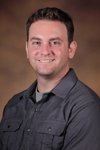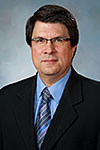Next UHV STEM lecture to discuss impact of gravitational waves detection
While the collision of two black holes was predicted by Albert Einstein 101 years ago, it had never been observed by humans.
That changed in September when scientists detected gravitational waves produced when two black holes merged. Brad Button, a UHV assistant professor of physics, will discuss the significance of this scientific breakthrough on March 30 at the University of Houston-Victoria’s next Science, Technology, Engineering and Math lecture.
Einstein’s Gravity and Gravitational Waves will take place from 4 to 5 p.m. in the UHV University West Alcorn Auditorium, 3007 N. Ben Wilson St. The event is free and open to the public.
The UHV School of Arts & Science began the STEM lecture series in 2015 to showcase success stories in science, technology, engineering and math. The series is designed to engage and inform students, faculty members and area residents about the expansive and broad research conducted by local and regional academic and professional researchers.
Button, who is the series founder, will talk about Einstein’s theory of gravity in the context of the detection of gravitational waves spotted on Sept. 14 by Laser Interferometer Gravitational-Wave Observatory detectors in Livingston, La., and Hanford, Wash.
“The detection gives a missing piece of astronomical observational data and offers further verification of Einstein’s general theory of relativity,” Button said. “The engineering precision needed to record the event and the sophistication of the data analysis gives physicists and astronomers a new set of tools to probe unobserved and theoretical features of the universe.”
Gravitational waves carry information about their origins and the nature of gravity that cannot be obtained otherwise. Physicists have concluded that the detected gravitational waves were produced during the final fraction of a second of the merging of two black holes to produce a single, more massive spinning black hole.
Button said the detection could lead to several additional discoveries.
“Further observations are expected to shed light on areas such as dark matter and offer insight into our cosmological model of the universe,” he said.
Button’s presentation is the third STEM lecture of the spring semester. Previous speakers were Brazilian math professor Cleon Barrosos and Folefac Atem, an assistant professor of biostatistics at the University of Texas Health Science Center in Houston.
The fourth lecture is scheduled for April 6. Aftab Alam, an adjunct lecturer teaching UHV’s petroleum technology courses, will discuss his work in the oil exploration industry.
“Dr. Button has done a fantastic job bringing in engaging speakers who have showed how STEM research is making a difference,” said Jeffrey Di Leo, dean of the UHV School of Arts & Sciences. “The series has been a great addition for our school.”
For more information about the series, contact Button at 361-570-4219 or buttonb@uhv.edu.
The University of Houston-Victoria, located in the heart of the Coastal Bend region since 1973 in Victoria, Texas, offers courses leading to more than 80 academic programs in the schools of Arts & Sciences; Business Administration; and Education, Health Professions & Human Development. UHV provides face-to-face classes at its Victoria campus, as well as an instructional site in Katy, Texas, and online classes that students can take from anywhere. UHV supports the American Association of State Colleges and Universities Opportunities for All initiative to increase awareness about state colleges and universities and the important role they have in providing a high-quality and accessible education to an increasingly diverse student population, as well as contributing to regional and state economic development.
Jeremy Shapiro
361-570-4350






